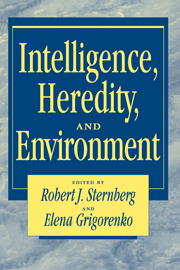Book contents
- Frontmatter
- Contents
- List of contributors
- Preface
- Part I The nature–nurture question: New advances in behavior-genetic research on intelligence
- 1 Behavior-Genetic and Socialization theories of intelligence: Truce and reconciliation
- 2 The puzzle of nongenetic variance
- 3 Identifying genes for cognitive abilities and disabilities
- 4 Heredity, environment, and IQ in the Texas Adoption Project
- 5 IQ similarity in twins reared apart: Findings and responses to critics
- Part II Novel theoretical perspectives on the genes and culture controversy
- Part III Specific issues in the nature–nurture controversy
- Part IV Integration and conclusions
- Name index
- Subject index
4 - Heredity, environment, and IQ in the Texas Adoption Project
Published online by Cambridge University Press: 05 June 2012
- Frontmatter
- Contents
- List of contributors
- Preface
- Part I The nature–nurture question: New advances in behavior-genetic research on intelligence
- 1 Behavior-Genetic and Socialization theories of intelligence: Truce and reconciliation
- 2 The puzzle of nongenetic variance
- 3 Identifying genes for cognitive abilities and disabilities
- 4 Heredity, environment, and IQ in the Texas Adoption Project
- 5 IQ similarity in twins reared apart: Findings and responses to critics
- Part II Novel theoretical perspectives on the genes and culture controversy
- Part III Specific issues in the nature–nurture controversy
- Part IV Integration and conclusions
- Name index
- Subject index
Summary
Historically, by far the most common design in human behavior-genetic studies has been the comparison of the resemblance of identical and same-sex fraternal twin pairs. It remains a basic approach today. The twin design permits the investigator to compare pairs of individuals of the same age and family environment, but of different degrees of genetic relatedness, on some trait of interest. A greater resemblance for those genetically more similar, the identical twin pairs, is taken as evidence of the importance of genes in contributing to individual differences on the trait in question. A second important design is the study of adoptive families. An adoption study examines the resemblance of genetically unrelated individuals growing up together in the same family, as parents and children or as siblings. If they are less similar than corresponding members of ordinary biological families, the difference is taken as evidence of the effect of the genes in causing the resemblance in the biological families.
Both twin and adoption studies also permit inferences concerning the effect of the shared family environment on traits. In the twin study, such inferences are indirect: If the twins are more similar than would be expected from the estimated genetic effect, an effect of shared environment is deduced. In the adoption study, the inference is direct: Do genetically unrelated family members show any resemblance at all? If so, there is evidence of the effect of the family environment (or possibly, of selective placement of children by adoption agencies); if not, the effects of the family environment, if any, are unsystematic.
- Type
- Chapter
- Information
- Intelligence, Heredity and Environment , pp. 105 - 125Publisher: Cambridge University PressPrint publication year: 1996
- 8
- Cited by

